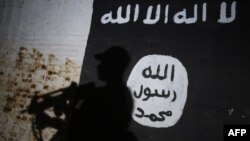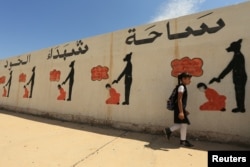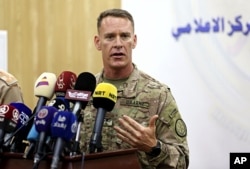The Islamic State terror group may be far more resilient, stronger and dangerous than U.S. officials have been willing to let on, boasting a fighting force in Iraq and Syria that comes close to what it fielded at its peak.
After four years of bombings, the elimination of key IS leaders, and other U.S. and coalition backed efforts, there are still anywhere from 28,600 to 31,600 IS fighters in Iraq and Syria, according to information given by the Defense Department to the lead inspector general for Operation Inherent Resolve and Operation Pacific Eagle–Philippines.
At the group’s height in 2015, U.S. intelligence officials estimated the terror group had about 33,000 fighters in Iraq and Syria, for a time, bolstering its numbers by bringing in thousands of foreign fighters every month.
Yet the new estimates suggest after spending $14.3 billion on more than 24,000 airstrikes, the U.S.-led coalition has managed to achieve only mixed results. While the Islamic State’s self-declared caliphate that spanned part of Iraq and Syria is no more, the U.S.-led effort has done little to erode IS’s overall might.
Thousands of IS fighters in Iraq & Syria
Instead, the inspector general’s quarterly report, citing Defense Department figures, shows IS may now be able to boast more than 17,000 fighters in Iraq.
Another 13,100 to 14,500 IS fighters are active in Syria, the report said, of which only 4,000 to 6,000 “remained in the U.S. military’s areas of operation in northeastern Syria.” The rest appear to be operating in areas controlled by the Syrian regime and its Russian and Iranian allies.
“Taken at face value, the U.S. government is saying ISIS has the same number of fighters in Iraq and Syria today as when the bombing campaign began,” said Thomas Joscelyn, a senior fellow at the Foundation for Defense of Democracies, using an acronym for the terror group.
“They are saying that ISIS was able to replace its entire force structure despite fighting multiple adversaries in both countries,” he added, noting the Pentagon’s 2017 claim that the bombing campaign and other efforts had killed 70,000 IS fighters.
VOA reached out to the Defense Department for more information on the estimates of IS fighters in the inspector general report. A spokesman said the department was looking into the matter.
There are concerns, internally, that the numbers may be at least misleading. A senior defense official told VOA it is possible the estimates could include fighters as well as family members or others with strong connections to IS, though not necessarily capable themselves of taking up arms or conducting terror attacks.
IS discipline ‘intact’
But the U.S. may not be alone in putting the number of IS fighters in Iraq and Syria in the tens of thousands. A new United Nations report Monday, based on intelligence from member states, estimated there are “between 20,000 and 30,000 [Islamic State] individuals, roughly equally distributed between the two countries.”
According to the UN report, those numbers include “a significant component” of the thousands of foreign terrorist fighters who flocked to Iraq and Syria to join the self-declared caliphate, warning they are not breaking rank.
“Despite the damage to bureaucratic structures of the so-called ‘caliphate,’ the collective discipline of ISIL is intact,” the report continued, using another of the terror group’s acronyms. “Although he is reported to have been injured, Abu Bakr al-Baghdadi remains in authority.”
Many U.S. military and counterterrorism officials, especially of late, have been reluctant to share intelligence on the number of IS fighters, calling such estimates, at best, an imperfect science. They also have tried to focus on the control of territory and on capabilities as more precise measures of the terror group’s strength.
'Hiding in onesies and twosies'
But the new estimates for the number of IS fighters in Iraq and Syria stand in stark contrast to what some officials have previously said publicly.
“You know, they are out in remote, sparse areas, or they are hiding in onesies and twosies amongst the population,” then Operation Inherent Resolve spokesman, Col. Ryan Dillon told VOA during a briefing this past April when asked about the IS presence in Syria.
“Any of the ISIS elements that the Iraqi Security Forces have encountered or found in Iraq, they have not exceeded four people at any one time,” he added at the time. “So that goes to show, potentially, a snapshot of what ISIS looks like when they don't hold territory.”
“They're really in the disarray,” French Brig. Gen. Frederic Parisot, director of civil-military operations for the coalition, told Pentagon reporters last month (July), estimating only “a few hundred” IS fighters were likely left.
The largest public estimate of the number of IS fighters in Syria came July 31, when the coalition’s deputy commander, strategy and support, British Maj. Gen. Felix Gedney, said it's likely more than 1,000 IS fighters were holed up in Hajin, near the Iraqi border, describing it as the “last remaining pocket of ISIS-held territory east of the Euphrates River.”
Islamic State still a potent threat
Still, few officials, even those citing a shrinking number of IS fighters in Iraq and Syria, have been willing to downplay the threat, or the difficulty of eliminating the terror group.
“I won't make any predictions about timing or anything on that. It will be done when it's done,” U.S. Central Command’s Gen. Joseph Votel told Pentagon reporters last week when asked about the coalition’s push into the last bastions of IS control in Syria. “Like most of our fights against ISIS, I expect that this will be a difficult one.”
“There is hard fighting ahead. That's all there is to it,” U.S. Defense Secretary Jim Mattis warned a day earlier. “I don't declare victory until it's in the rearview mirror.”
Yet the new inspector general report is just one of several that suggest it could be some time before victory can be declared in Iraq and Syria, or elsewhere.
U.S. counterterrorism officials told VOA last week the IS province in Afghanistan, known as IS-Khorasan, has more than 1,000 fighters, almost double what the terror group had at this time last year two decapitation strikes and the use of the largest non-nuclear bomb in the U.S. arsenal on a suspected IS cave and tunnel complex.
Another report, published this month by the Combatting Terrorism Center at West Point, estimated there are also “approximately 6,000 Islamic State fighters in Africa today, spread over a total of nine Islamic State ‘cells.’”
Even in places like the Philippines, where the IS presence has been beaten back, a couple hundred fighters continue to hold on, supported in part by criminal gangs that specialize in drugs and money laundering, according to U.S. defense officials.
“ISIS is in the process of a largely successful transition to a networked terrorist organization, albeit evoking more of a global consciousness than al-Qaida,” according Nicholas Glavin, formerly a researcher at the U.S. Naval War College’s Center on Irregular Warfare and Armed Groups.
“This illustrates the mounting challenge faced by our partners in Iraq and Syria to deliver ISIS an enduring defeat,” Glavin said.












